Schwartz studies rewilding efforts in Holland, Germany
Last week David Schwartz, Professor of Philosophy and the Mary Frances Williams Chair in Humanities, conducted research in various rewilding sites in Holland and Germany. The work supported a current project on the ethical issues raised by environmental rewilding.
According to the Oxford Research Encyclopedia, rewilding is the process of maintaining or even increasing biodiversity through the restoration of ecological and evolutionary processes using extant keystone species or ecological replacements of extinct keystone species that drive these processes. It is hailed by some as “the most exciting and promising conservation strategy to slow down or stop what is considered to be the greatest mass extinction of species since the extinction of dinosaurs 65 million years ago.” However, some have raised concerns that rewilding has only limited inroads within the conservation mainstream, and still has to prove itself in practice.
Schwartz visited a series of sites to see the process of rewilding in action. Here are the places and things he observed:
Taurus Breeding Program
“This program seeks to back-breed from six different breeds of cattle to something resembling the extinct aurochs. The skull in the first photo is from an actual aurochs, the species from which all domesticated cows derived and which went extinct in 1627. As you can see, it is quite a bit larger than the animals in the second (close-up) photo, which are too small for release. More representative of what they aim for is the animal seen in the distance of the third photo (of a grazing field with a man in the left foreground).
The photo of what looks like an overpass is called an eco-pass, a man-made land bridge to facilitate safe wildlife movement/migration. There are lots of them all over the larger highways in Holland.”

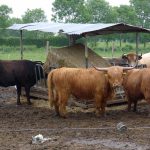


Oostvaardersplassen Nature Preserve
“Spent a full day at Oostvaardersplassen Nature Preserve. If ever there was a place to confound one’s sense of ‘nature,’ then this is it! On a polder of land created in 1968 to be an industrial park (that never happened), Frans Vera and other visionary ecologists convinced politicians to designate it as a nature preserve where nature could run wild and recreate the Dutch landscape before humans began intensively cultivating it centuries ago. And more importantly, it would provide a habitat for the return of species displaced by human development.
Of course, getting nature to do such a thing required a bit more human intervention than just creating the land. Next was introducing proxies for two extinct species crucial to the region’s early ecology—the aurochs and the tarpan. The proxies chosen were Heck cattle for the aurochs and Konik horses (a wild pony from Poland) for the tarpan. In the 1990s, red deer (antelope) were introduced.
In the photos below, you can see the Konik horses up close, and one photo is a panorama showing a herd of deer in the foreground and a herd of Heck cattle in the background. As a place where nature runs its course, the photo of skeletal remains is the carcass of an animal that didn’t survive a recent harsh winter (more about that later, as animal welfare protesters have really criticized the Oostvaardersplassen project). Perhaps the biggest unequivocal benefactors of the project are birds and water fowl. Numerous bird species have returned to the area after being gone for decades/centuries.
In touring the area, I found myself wondering over and over: What exactly is this place? Is it a nature preserve or a garden park? A bit of both, no doubt. In fact, recent policy changes have led to planting trees and fencing off small areas, both to further recreate the original ecology and increase biodiversity of plants and animals (especially birds and insects). And while the electrical power lines and wind turbines may seem out of place, that’s all part of the beauty—it’s easy to forget that all of this is happening right in the middle of one of the most densely developed areas of the world, 20 miles from Amsterdam!
Is this rewilding? Well, sort of, although it’s hard to rewild an area of land that didn’t really exist until 1968! Some Dutch call it ‘New wilderness,’ others call it ‘New nature,’ which seems closer to the mark. Whatever one calls it, valuable lessons and knowledge for our environmental future are being learned here.
Headed out today for the Elbe River Bioreserve in Germany. Time to pack up the Toyota Yaris hybrid and hit the road.”




Elbe Biosphere Reserve
“The last official act of the East German (Deutsche Demokratische Republik, or DDR) government before dissolving in 1990 was to enact the proposal of a renegade biologist-turned-bureaucrat named Michael Succow. Knowing German reunification was imminent, Succow persuaded the politicians to adopt a sweeping proposal to set aside 7 percent of all land in the DDR for nature preserves and nature parks, a move that he knew would be binding on the government of a unified Germany. Hence was born a vast network of national parks and reserves, including the Flusslandschaft Elbe Biosphere Reserve, the largest reserve in Germany and now a lUNESCO-recognized biosphere reserve.
I spent the day with Jan Schormann, deputy director, who took me on a driving tour of the reserve. Jan explained both successes and challenges from his work. One of the biggest successes has been a dike relocation project along the Elbe River. Because of its relative closeness to the river, the old dike protected the nearby towns from flooding but allowed very little room for floodwaters to create wetlands and rejuvenate the soil. After much negotiation and discussion with the local citizenry, a 10-year project was begun to build a new dike further inland. Cuts were then made in the old dike to allow river flood waters to flow to the new dike. The result significantly improved the ecology while providing even better flood protection. For example, a bad 2003 flood nearly breached the old dike, requiring the military to haul in 2 million sandbags to prevent catastrophic flooding. After the dike relocation, an even worse flood in 2013 needed no such intervention. Thus, better flood protection and a much bigger, healthier flood plain.
Below are some pictures of the project. The first shows the two dikes, as marked (with recently planted seedlings in the middle). The second photo shows one of the cuts in the old dike. The third shows the path of the old dike with a strange structure in the background (more on it later).
Perhaps the biggest struggle facing the bio reserve work (besides money) is persuading local citizens to go along with their projects. For example, Jan and his team have plans for a project to restore a large natural moor in the area. Critical to storing carbon and reducing greenhouse gases, 85 percent of moors, bogs, and other such wetlands have been lost to human development, according to a recent UN climate report.
The moor in Elbe has been damaged by humans draining it so that the land can be used for agriculture, in this case grazing cattle. The practice has been going on for centuries at a small scale, but it was ramped up exponentially by the East German government in the 1980s to increase food production. When water is extracted from the moor, the peat breaks down and releases its carbon into the atmosphere (and the land slowly sinks). So far, Jan and his team have been unsuccessful in persuading local farmers to sell their land to the reserve so that the degradation can be stopped. Much of the resistance is based on cultural tradition (“we’ve done it this way for centuries”) not economics, as the cattle are being raised mostly as a hobby than for a livelihood.
While the reserve has the political authority to seize the land by eminent domain, Biosphere officials refuse to use such heavy-handed tactics. Not only would it be morally suspect, but they believe persuasion is the only route to changing environmental attitudes. After 45 years of totalitarian control, the locals are in no mood for top-down, imposed solutions. Some of this resistance goes back to how the Biosphere Reserve was created in the first place—imposed by an act of the East German government with no local input. As local critics were fond of saying at the time, “We want jobs, not owls.” Jan’s hope is to show that they can have both.
Below are some photos of the moor on question. The first picture shows how the moor is now used as a grazing area for cattle. The next pictures show Jan showing how the peat has deteriorated into common topsoil. The third photo shows a section of what a healthier moor would look like, covered with a grass called phragmites australius, which is adapted to grow in the moor environment. If the project happens, more of the moor will look this way, helping with climate change and ecotourism to the area will provide an economic boost for the local economy.
Much more to come about the Elbe region!”



White Storks
“One of the many amazing things happening in the Elbe River Biosphere Reserve is the annual migration of white storks. Each year the storks make the long flight from South Africa to Northern Europe, spending March to August here before returning south.
But rather than having to hike through woods or wetlands to see these beautiful birds, there is no better place to go than the town of Rühstädt, which bills itself as the stork capital of Germany. Jan Schormann described the storks as “culture followers,” a fascinating term for animals (including humans) whose life is intimately tied to cultural landscapes. For the storks, one thing this means is stalking around freshly mowed hayfields where worms and other foodstuffs are much easier to find than in the wild. Another thing it means is a preference for building their nests on the rooftops of barns and other large structures. The storks typically return to the exact same nest each year, and fights can break out if they return to find an interloper on their ‘property.’
The pictures below show some of the nest configurations, as well as a stork prowling around in a freshly mowed hayfield. In one photo a fledgling pokes its head up looking for some dinner. The photo with three storks flying around a nest is one of those conflicts I mentioned. A female sits in the nest as two males challenge to be her mate. Jan explained to me that the storks’ first priority is always maintaining control of the nest. They would rather change mates than lose the nest. Because preserving property seems to come before all else, he thinks that at heart the storks may be capitalists!”


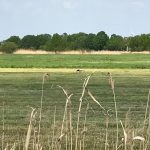

The Green Belt
“Thirty years ago, millions watched as the Berlin Wall came tumbling down. Less known was the gargantuan task of tearing down the 7,500-mile Iron Curtain that ran from the Barent Sea in the north all the way to the Adriatic Sea in the south. Far from a mere line on a map, this border consisted of a 100-300-meter strip of land, edged by electrified steel fences and filled with a variety of death-dealing measures such as land mines, razor wire, trip wires, and automatic machine guns. In Germany, the 740 miles of border was constantly patrolled by thousands of soldiers from a series of 800 watchtowers connected by a service road called the Kollonenweg.
Because this strip of land was for obvious reasons a ‘no go zone,’ very little changed here during the 45 years of the Cold War—no new housing, roads, agriculture, or development of any kind. As a result, this instrument of oppression and suffering became one of the most environmentally-preserved areas in all of Europe, with high biodiversity and many threatened species. As the border began falling in the euphoria of European reunification, a simultaneous environmental movement began, aiming to preserve the rich ecology of the border strip while celebrating the newly free and united Europe. Systematically, land was purchased (or donated) and put under protection. In 2003, Mikhail Gorbachev famously endorsed the project. Thus was born the European Green Belt. Each country administers their own section of the project, with the German Green Belt being perhaps the most ambitious and active.
In the Elbe River area, the east/west boundary was the river itself, with the border fence, watch towers, and Kollonenweg about 100 meters east of the river. In fact, the border fence was built directly on top of the dike I discussed in an earlier post. This means that 30 years ago, I would have been shot for even standing there! Subsequently, I have crisscrossed the border several times in driving south to the Harz National Park. There I hiked on the Harz Border Trail, which follows the Kollenenweg and passes right by the Brocken, a mountain famous in German history and literature.
According to Hermann Martens, who works with the German Green Belt in Harz National Park, some visitors come to see Cold War history and then connect with nature while in the park. Conversely, some come for the nature and learn about the history. It’s a curious dynamic, and it echoes something Caroline Fraser notes in her book, Rewilding the World. Fraser writes that the most successful rewilding projects often happen on land where there has been some sort of cultural upheaval or catastrophe. Hermann told me that in recent years official government delegations from South Korea have come to the Harz to study the Green Belt, preparing for what they hope will one day be their own moment of reunification (the Korean demilitarized zone is one of the most pristine and biodiverse places in Asia). Right now a united Korea may feel like a pipe dream, but then again I never dreamed I would ever be able to walk the Kollonenweg or climb an East German watchtower. So maybe there is a silver—or at least green—lining to these awful conflicts.”



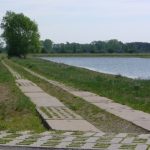


Wolves
“Perhaps the most famous rewilding success story ever is the reintroduction of wolves into Yellowstone National Park in the 1990s. Yet wolves are now returning to Western Europe, and this time they are reintroducing themselves, thank you very much. Extirpated from Western Europe in the 20th century, wolves have been slowly migrating west from countries such as Poland and establishing new populations in highly populated countries such as Germany, France, and even Holland. According to Jan Schormann, there are two breeding wolf packs in the Elbe River Biosphere Reserve alone.
Wolves are of course no ordinary animal, having attained mythical status in human culture through tales such as Little Red Riding Hood. While many Germans (mostly those who live in large cities) are ecstatic about the return of the wolf, others (mostly those who live in rural areas) see wolves as a menace to their family and livelihood. From exaggerated stories about wolves killing livestock and even abducting children, they believe that tolerating wild wolves is a step too far in environmental preservation. In fact, the very day I arrived in the Elbe Reserve, a bill was introduced in the German Bundestag to ease prohibitions on hunting wolves when livestock are harmed. Until now, government policy toward wolves was essentially one of toleration—farmers received compensation for any lost livestock, but the wolves could not be harmed.
One thing the tolerance policy requires is lots of money. In addition to the money needed to compensate farmers for livestock loss, many farmers have opted to buy canine protection services for their animals (mostly sheep). Bred in the Balkans specifically to guard livestock from wolves, these dogs are expensive to buy and maintain, adding to the farmers’ economic woes. While wolf fencing may seem like an obvious alternative, it has its own drawbacks. Not only is it expensive to build, but it also has the environmental drawback of keeping out all sorts of other critters important to the health of the land. This is because the electrified wires must be much lower to the ground than traditional cattle fencing.
Like so much in politics these days, social media is playing a role in this controversy. Jan explained to me that while wolves do sometimes kill sheep, it is relatively rare. And wolf/human encounters are almost non-existent. Yet while the number of people opposed to the wolves is a small minority, they are good at using social media to amplify wolf events and whip up political opposition.
Below are some wolf-related pictures. The first two show a taxidermied wolf on display at the visitor center of Harz National Park. Next is a sign posted in the Elbe River Biosphere Reserve informing passersby that sheep grazing in the area are being protected by guard dogs. It warns not to engage with the dogs, to keep one’s distance, and to secure any pets on a leash. The next photo is of three of these specialized dogs watching over some sheep. While they may look like cuties, the next photo shows how they reacted when Jan and I drove by. Next is a photo of Jan explaining how traditional cattle fencing would need to be supplemented to keep out wolves (but that would also deter many other species from moving across the land). The last photo shows a brochure advertising an adventure tourism opportunity related to wolves. Tourism is a consistent and central theme across all the rewilding projects I have seen on the trip.”


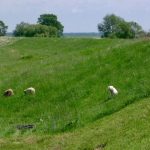

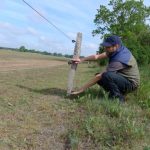
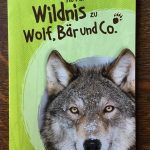 Tags: comparative philosophy, David Schwartz, environment, faculty, faculty research, Faculty Scholarship, philosophy, rewilding
Tags: comparative philosophy, David Schwartz, environment, faculty, faculty research, Faculty Scholarship, philosophy, rewilding
